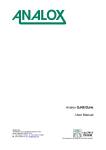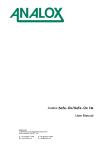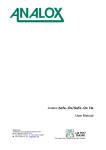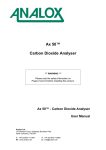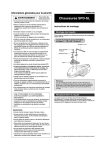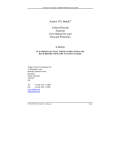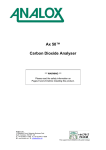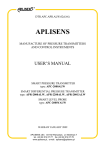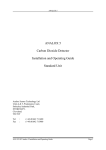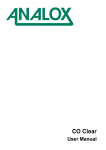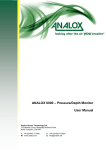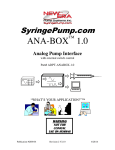Download Analox O2NE/O2He User Manual
Transcript
Analox O2NE/O2He User Manual Analox Ltd. 15 Ellerbeck Court, Stokesley Business Park North Yorkshire, TS9 5PT, UK T: +44 (0)1642 711400 W: www.analox.net F: +44 (0)1642 713900 E: [email protected] Analox O2NE/O2He – User Manual Contents Safety Information ................................................................................................................................... 1 Package Contents Checklist.................................................................................................................... 2 About the Product.................................................................................................................................... 3 Capillary sensor ............................................................................................................................... 3 Diffusion sensor ............................................................................................................................... 3 Effect of helium on a capillary sensor .............................................................................................. 4 Installation of the Product ........................................................................................................................ 7 Wall mounting .................................................................................................................................. 7 Wiring Installation ............................................................................................................................ 7 Options available ..................................................................................................................................... 7 AC supply models ............................................................................................................................ 7 DC supply models............................................................................................................................ 7 Alarm repeaters ............................................................................................................................... 8 Alarm relay output models ............................................................................................................... 8 Relay wiring ..................................................................................................................................... 8 Battery back-up................................................................................................................................ 9 4 to 20mA output models................................................................................................................. 9 Normal operation ........................................................................................................................... 10 Alarm indications ........................................................................................................................... 10 MAINTENANCE .................................................................................................................................... 11 Oxygen sensor replacement.......................................................................................................... 11 Calibration...................................................................................................................................... 11 Full calibration check ..................................................................................................................... 12 Alarm checks ................................................................................................................................. 13 Adjusting alarm set points.............................................................................................................. 13 Fault conditions.............................................................................................................................. 14 SPECIFICATIONS................................................................................................................................. 15 DISPOSAL............................................................................................................................................. 16 DECLARATION OF CONFORMITY...................................................................................................... 17 DRILLING TEMPLATE .......................................................................................................................... 18 Document Ref: AA1-810-17 - November 2012 Analox O2NE/O2He – User Manual Safety Information The Analox O2NE™/ O2He™ is designed to be compliant with the following standards: EN61010-1: 2001, IEC61010-1: 2001, CAN/CSA-C22.2 No. 61010-1 Second Edition 2004, ANSI/UL 61010-1 Second Edition 2005. It is designed to be safe at least under the following conditions. 1) Indoor use 2) Altitude up to 2000m 3) Temperature -5°C to +40°C 4) Maximum relative humidity 80% for temperatures up to 31°C decreasing linearly to 50% relative humidity at 40°C. 5) Mains voltage supply fluctuations not to exceed 10% of the nominal voltage 6) Impulse withstand (over-voltage) category II of IEC 60364-4-443 7) Pollution degree 2 8) Mains voltage:230V AC (Not Adjustable - Instrument will be factory set) 110V AC (Not Adjustable - Instrument will be factory set) 24V DC (Not Adjustable - Instrument will be factory set) 9) Mains power:Less than 5VA – 110V AC and 230V AC Versions Less than 5W – 24V DC Version. 10) Mains frequency - 50/60Hz 11) The Remote Alarm Repeater has ingress protection to IP43: direct sprays of water up to 60 from the vertical in accordance with EN 60529:1991 + A1. All other units have ingress protection to IP65: low pressure water jets from all directions and totally protected from dust in accordance with EN 60529:1991 + A1. 12) Insulation: - Reinforced insulation, class II product according to IEC536. 13) Not for use in corrosive or explosive atmospheres 14) Not approved for use in vehicles, ships or aircraft Fuse ratings:230V AC, 500mA, 110V AC, 500mA, 9-24V DC, 200mA, F rating 250V (20mm x 5mm Glass Cartridge) F rating 250V (20mm x 5mm Glass Cartridge) AS rating 250V (20mm x 5mm Glass Cartridge) Battery Back-Up:The Battery Back-Up is non repairable. Please return faulty units to Analox for refurbishment/replacement. 4 to 20mA (or 0-1V) Output:Connected equipment must meet the requirements for reinforced insulation. NOTE - If the equipment is used in a manner not specified by the manufacturer, the protection provided by the equipment may be impaired. Document Ref: AA1-810-17 - November 2012 Page 1 Analox O2NE/O2He – User Manual Package Contents Checklist On receipt of the Analox O2NE™/ O2He™ please check you have the following: 1) 2) 3) 4) 5) Analox O2NE™/ O2He™ main unit and Alarm Repeater User Manual Test Certificate Rawl Plugs and Screws for Wall Mounting Drilling Template Any optional items ordered such as: 1) 2) Additional Alarm Repeater’s each with 8 metres of interconnecting cable. Relay junction box Document Ref: AA1-810-17 - November 2012 Page 2 Analox O2NE/O2He – User Manual About the Product Two variants of this product are available. The Analox O2NE™ O2 detector is designed to detect the presence of low Oxygen in ambient air. The Analox O2He™ O2 detector is designed to detect the presence of low Oxygen in ambient air where high levels of Helium (He) gas are present. Instrument Name Analox O2NE™ Analox O2He™ Application Fixed instrument configured as standard with two depletion alarms, representing warning (19.5%) and danger (18%) levels of oxygen Fixed instrument configured as standard with two depletion alarms, representing warning (19.5%) and danger (18%) levels of oxygen, specifically for use in areas where oxygen depletion is due to the use of helium (eg saturation diving) Sensor Type Capillary Diffusion Capillary sensor The capillary type of sensor measures the percentage of oxygen in the atmosphere where the instrument is located. It is essentially immune to fluctuations in atmospheric pressure. It is however affected by the presence of background helium, which makes it questionable for use in an environment subject to oxygen depletion by helium. Diffusion sensor The diffusion type of sensor measures the partial pressure of oxygen in the atmosphere where the instrument is located. Therefore it is directly affected by fluctuations in atmospheric pressure, and can in extreme conditions generate nuisance alarms due to the lack of oxygen in the atmosphere caused simply by, for instance, a very low pressure weather front. Unlike the capillary sensor though, the diffusion sensor will work correctly in helium environments. The reading is presented to the user as an assumed percentage value, simply by saying that a partial pressure of 209 mBar ppO2 is equivalent to 20.9% oxygen. This is of course only true at an atmospheric pressure of 1000 mBar. Different versions of the instrument allow operation from 1) 210/250V AC supply 2) 110/120V AC supply 3) 9-24V DC supply The Analox O2NE™/ O2He™ is intended to be used as permanent installation. It provides a digital readout of oxygen, plus audible and visual alarms to potentially dangerous deficiencies of oxygen in the air surrounding the instrument. The instruments use an Electrochemical cell together with state of the art technology built in an IP65 splash proof housing and is designed to provide long, trouble free service, with minimum maintenance. The Analox O2NE™/ O2He™ has two pre-set alarm levels at 19.5% and 18% O2. The alarms are set with a small hysteresis which means the O2 concentration has to rise above the alarm set point before the alarm cancels. Document Ref: AA1-810-17 - November 2012 Page 3 Analox O2NE/O2He – User Manual Optional items fitted to or supplied with the unit may include the following: 1) Remote Alarm Repeater* 2) One or two medium duty relays 3) Test Gas, flow indicators and control valves* Items marked with an asterisk (*) do not need to be specified at the time of order and may be retro fitted. Effect of helium on a capillary sensor Helium is used widely in industrial applications, for example in magnetic resonance imaging equipment in hospitals and for offshore saturation diving. When a capillary sensor is exposed to helium, for instance caused by a spill or leak, the helium will cause the capillary sensor to give a higher than expected reading. Although not toxic, if helium is spilled or released in high levels into a confined space it can result in oxygen depletion. If capillary oxygen sensors are being used to monitor the levels of oxygen they can give readings that are high – this is potentially dangerous when monitoring oxygen depletion. The reason for this phenomenon is down to the small size of the helium molecule. When present in high concentration, the helium molecules diffuse rapidly through the capillary into the oxygen sensor and at the same time allow more rapid diffusion of the much larger oxygen molecules. The result of this process is more oxygen molecules enter the sensor which results in artificially high readings. It is preferable to use a partial pressure sensor when measuring oxygen in ambient environments where helium leaks and spills could occur. These sensors have a solid membrane diffusion barrier in place of the capillary and do not suffer the same effects as the capillary sensors. Let us now investigate the issue further and show the extent of the effect caused by helium. This will allow an informed decision on whether the issue is relevant in a particular application. Firstly let us look at the effect of pure helium leaking into a given atmosphere. As the concentration of helium increases, it will displace air from that atmosphere. As the air is displaced, the concentration of oxygen will fall, as shown in Figure 1. 22 21 % Oxygen 20 19 18 17 16 15 0 5 10 15 20 25 30 % Helium Figure 1: Depletion of oxygen by helium in an atmosphere This graph shows us that the alarm limits of 19.5% and 18% oxygen relate to helium concentrations of approximately 7% and 14%. Figure 2 shows us the sensitivity factor of the capillary sensor in the presence of varying levels of helium. With zero helium, we are saying that the sensitivity factor is 1.0. That is to say that the sensor will give a correct oxygen reading. As the helium increases, so too does the sensitivity factor. Document Ref: AA1-810-17 - November 2012 Page 4 Analox O2NE/O2He – User Manual At 7% helium, the sensitivity factor is approximately 1.055. This means that with say a sample of 19.5% oxygen, the sensor will indicate 1.055 x 19.5% (=20.6% oxygen). Also an alarm setpoint of 19.5% will require a level of oxygen less than 19.5/1.055 (=18.5% oxygen) to successfully trigger. At 14% helium, the sensitivity factor is approximately 1.1075. This means that with say a sample of 18.0% oxygen, the sensor will indicate 1.1075 x 18.0% (=19.9% oxygen). Also an alarm setpoint of 18.0% will require a level of oxygen less than 18.0/1.1075 (=16.3% oxygen) to successfully trigger 1.18 1.16 1.14 Sensitivity factor @ 14% He ≈ 1.1075 O2 Sensitivity factor 1.12 1.1 1.08 1.06 1.04 Sensitivity factor @ 7% He ≈ 1.055 1.02 1 0.98 0 5 10 15 20 25 % Helium Figure 2: Sensitivity factor of oxygen sensor in presence of helium Whilst these numbers are not dramatically incorrect, and are probably unlikely to cause harm to personnel, they are still sufficiently erroneous that Analox would advise considering use of the diffusion type of sensor in such applications. Effect of atmospheric pressure on a diffusion sensor We will assume that the instrument has been calibrated to read 20.9% when it is measuring 209mBar ppO2 at an atmospheric pressure of 1000 mBar. 230 Oxygen (ppO2 mBar) 220 210 200 20.90% 190 19.50% 18.00% 180 170 160 150 940 960 980 1000 1020 1040 1060 Atmospheric Pressure (mBar) Figure 3: Variation of oxygen with atmospheric pressure Document Ref: AA1-810-17 - November 2012 Page 5 Analox O2NE/O2He – User Manual Figure 3 demonstrates the readings obtained from sensors at different atmospheric pressures when subjected to three samples of oxygen – 20.9% which is taken as normal air, and then levels corresponding to the two typical alarms – 19.5% and 18.0%. You can see that a sample of 20.9% oxygen will measure just under 198.5mBar (ie display 19.85% oxygen) at 950mBar atmospheric pressure. In theory that is satisfactory in that it will not lead to a nuisance alarm. The nuisance alarm would occur if the reading fell to 195mBar oxygen, which is equivalent to 20.9% oxygen at an atmospheric pressure of 933mBar. Also a genuine 19.5% sample of oxygen will measure 204.75mBar at 1050mBar atmospheric pressure. This means that under these conditions, the sensor will not go into alarm. It would actually require a gas of 18.5% oxygen to trip an alarm set at 195mBar when the atmospheric pressure is 1050mBar. Likewise, at 1050mBar atmospheric pressure, the test gas to achieve the second alarm (normally 18%, or 180mBar), would be 17.1%. To summarise, low atmospheric pressures increase the likelihood of a nuisance depletion alarm, and high atmospheric pressures lead to reducing the effective alarm set point. The examples shown here are fairly severe. Atmospheric pressure in many locations will very rarely reach the figures quoted here. Document Ref: AA1-810-17 - November 2012 Page 6 Analox O2NE/O2He – User Manual Installation of the Product Wall mounting The Analox O2NE™/ O2He™ should be mounted onto a wall at normal working head height using the mounting lugs; a paper drilling template is included in Section 12 of this manual. Use the paper template to drill the 4 required holes in the wall and use the Rawl plugs and screws provided to mount the unit. It is not necessary to dismantle the Analox O2NE™/ O2He™ main unit in any way prior to installation. You need to ensure the mains plug, fused at 3 amps is in easy reach of a power socket. The Alarm Repeater housing also has wall mounting lugs. Wiring Installation It is necessary to identify the model of Analox O2NE™/ O2He™ prior to installation. The Calibration Certificate accompanying each instrument will clearly identify the information required. *** ENSURE THAT THE ELECTRICAL SUPPLY TO THE INSTRUMENT IS SWITCHED OFF WHILST INSTALLING ANY WIRING *** Options available AC supply models Mains powered Analox O2NE™/ O2He™'s are pre-wired with a mains cable, fitted with a plug suited to the destination country. Where internal plug fuses are fitted, these are 3 Amp. Ensure that the unit is connected to the correct supply voltage (i.e. 110 or 230V AC). Where no fuse is fitted in the plug, the instrument should be powered from a 3 Amp fused outlet. The Analox O2NE™/ O2He™ is fitted with an internal fuse, which is rated at 500mA. DC supply models DC powered Analox O2NE™/ O2He™'s require a DC supply in the range 9-24V DC. A 2m cable is factory fitted to the instrument. The DC supply should be connected to this cable as follows: 1) 2) Blue wire negative (0Volts) Red wire positive (+9-24Volts) Document Ref: AA1-810-17 - November 2012 Page 7 Analox O2NE/O2He – User Manual Alarm repeaters The Alarm Repeater has four status indicators and a Mode button, which mimic the button and indicators on the main Analox O2NE™/ O2He™ enclosure. An 8 metre, 8 core cable is pre-wired to the Analox O2NE™/ O2He™ on units to be fitted with an alarm repeater. This ensures that for a basic installation, there is no need to dismantle the Analox O2NE™/ O2He™ main unit. A maximum of three repeaters may be fitted in a daisy chain configuration. To connect and disconnect a “Quick Connect” Repeater: 1) 2) 3) Disconnect the power supply from the Analox O2NE™/ O2He™. Insert the connector on the end of the cable into the socket on the base of the Alarm Repeater. Restore power to the Analox O2NE™/ O2He™. Press the mode button on the repeater once, and ensure that the four indicators flash. Note that in the presence of a genuine alarm, the test feature is disabled. Alarm relay output models You may have ordered your Analox O2NE™/ O2He™ with a relay. The relay contacts are ‘Volt-Free’ single pole Changeover, rated 250vAC/30vDC 2 Amps. The relay is non-latching. This means the relay will only initiate when gas is present. As standard the relays are setup in a Fail-Safe configuration. This means that the relay is energised during normal operation. Please note that on power up the relay is only energised after the 40 second warm-up period. See below for details of how the relay should be connected. Relay wiring The cable gland is for cables of outside diameter between 5 and 7mm, if cable fitted is outside that range, a suitably specified cable gland must be used. Ensure that the gland is properly tightened. Test that the cable is adequately gripped by the cable gland. Ensure that the cable is suitable for purpose, the load is within the limits of the relay, 240VAC/28VDC, 2Amps, and the insulation of the external circuit meets the requirements for basic insulation 240VAC/28VDC, 2 Amps. After completing wiring, ensure that the terminal box cover is securely replaced. RELAY TERMINAL BOX TERMINATIONS RELAY TERMINAL BOX TERMINATIONS Document Ref: AA1-810-17 - November 2012 Page 8 Analox O2NE/O2He – User Manual Battery back-up When this option is fitted the Analox O2NE™/ O2He™ should remain powered for at least 30 hours to ensure the Battery Back-up is fully charged and will provide back-up power for a minimum of 4 hours in the event of Mains power failure. 4 to 20mA output models You may have ordered your Analox O2NE™/ O2HE™ with a 4 to 20mA output. A 2m cable is factory fitted to the instrument. The 4 to 20mA output current is generated by the instrument. The customer system should be connected to this cable as follows and as per the following drawing: 1) Blue wire 4 to 20mA negative 2) Red wire 4 to 20mA positive (Max load 150 Ω) Document Ref: AA1-810-17 - November 2012 Page 9 Analox O2NE/O2He – User Manual OPERATION Normal operation When the Analox O2NE™/ O2He™ is turned on it will take approximately 10 seconds to warm up and stabilise. During this period, the 'Good/OK' and 'Fault' status indicators will be turned on. After the initial stabilising period has expired, the 'Fault' status indicator will turn off. The 'Good/OK' status indicator will be illuminated and flash off briefly every few seconds, indicating normal operation. The status indicators on any Alarm Repeaters will mimic this operation. On display models the display will briefly read ‘.8.8.8.8’ on power up before reverting to the O2 reading. Alarm indications If the Analox O2NE™/ O2He™ detects an O2 concentration which is less than the first alarm level, then the 'Alarm 1' indicator will begin to flash and the buzzer will sound at its slow speed. If the measured concentration of O2 continues to fall below the second alarm level, then the ‘Alarm 2' indicator will begin to flash and the buzzer will sound at its medium speed. The 'Alarm 1' indicator will continue to flash. On standard units the alarms are self-cancelling when the O2 level rises above the alarm limits. Alternatively, latched alarm versions are available, on which the alarm conditions will be maintained until the Mode switch has been pressed to accept the alarm, and the gas level has risen above the alarm threshold. Momentarily pressing the 'Mode' button on the Analox O2NE™/ O2He™ or any Alarm Repeaters, in the absence of any alarm conditions, causes an alarm test to be performed. The indicator lamps will flash 4 times and the buzzer will sound. In all circumstances the Alarm repeater will mimic the status indications and buzzer of the main unit. Units fitted with relays are configured such that relays may operate in conjunction with Alarm1 or Alarm2. They are factory set to be energised in the absence of alarms, and de-energised in the presence of alarms. They may be factory configured in the opposite sense if required. Document Ref: AA1-810-17 - November 2012 Page 10 Analox O2NE/O2He – User Manual MAINTENANCE Oxygen sensor replacement Analox O2NE™ The oxygen sensor is mounted in a special housing on the under-side of the Analox O2NE™ enclosure. This housing allows the oxygen sensor to be easily replaced when necessary. The sensor will last in air for up to three years. It is recommended to replace the sensor at two year intervals. The procedure for replacing the cell is as follows: 1) 2) 3) 4) 5) 6) 7) 8) 9) 10) Switch off the instrument Use a large flat blade screw driver to release the push fit housing. This is done by inserting the blade into the recess under the flange of the housing and twisting the screwdriver. The oxygen sensor will now be visible. Gently pull the sensor downwards to release it from the bulkhead. It will be retained by an electrical connector. Carefully pull the electrical connector from the rear of the oxygen sensor Fit the new oxygen sensor to the connector, note it will only connect one way round. Remove the old O-Ring from the side of the housing and fit the new one supplied with the replacement sensor Carefully push the sensor into the housing and then firmly push the housing and wiring back into the Bulkhead on the under-side of the Analox O2NE™ enclosure. Switch the instrument on Perform a Quick Calibration Check to calibrate the new sensor Test the operation of the oxygen alarms. Analox O2He™ The oxygen sensor is mounted in a special housing on the under-side of the Analox O2He™ enclosure. This housing allows the oxygen sensor to be easily replaced when necessary. The sensor will last in air for up to three years. It is recommended to replace the sensor at two year intervals. The procedure for replacing the cell is as follows: 1) 2) 3) 4) 5) 6) 7) 8) 9) 10) Switch off the instrument Unscrew the sensor housing cap by rotating it in an anti-clockwise direction The oxygen sensor will now be visible. Gently pull the sensor downwards to release it from the bulkhead. It will be retained by an electrical connector Carefully pull the electrical connector from the rear of the oxygen sensor Fit the new oxygen sensor to the connector, note it will only connect one way round Carefully push the sensor into the housing Refit the sensor housing cap by placing it on the end of the sensor housing and rotating it in an clockwise direction Switch the instrument on Perform a Quick Calibration Check to calibrate the new sensor Test the operation of the oxygen alarms Calibration Note: Gases used on the Analox O2NE™/ O2He™ must be manufactured to a ±2% tolerance. Quick calibration check A quick calibration check should be performed on the Analox O2NE™/ O2He™, when it is first installed, then at no greater than 3 monthly intervals, and must be performed every time a new sensor is installed. This ensures that the sensor is giving an accurate Oxygen reading. Document Ref: AA1-810-17 - November 2012 Page 11 Analox O2NE/O2He – User Manual In order to perform a calibration check, you will need the following equipment: 1) 2) 3) Test Gas with 24% Oxygen in Nitrogen, +/-2% tolerance - Part No: SA7L201160 Fine control valve - Part No: SA7FLOWIN Flow adaptor - Part No: 8000-0069A Then follow the procedure: 1) Fit the flow adaptor to the O2 sensor and connect, with tubing, the cylinder and set the fine control valve to half scale allowing the gas to flow over the sensor (see Figure 2) 2) When the display reading settles at 24% ±1%, press the 'Mode' button for 2 seconds. On releasing the button there should be a confirming beep. The Analox O2NE™/ O2He™ is calibrated. If the confirming beep is not heard, or the display reading does not settle between 23% and 25% you need to carry out a full calibration as described in Section Full calibration check. Fitting the flow adaptor Full calibration check A full calibration check should be performed on the Analox O2NE™/ O2He™, when it fails to calibrate using the quick calibration check. In order to perform a calibration check, you will need the following equipment: 1) 2) 3) Test Gas with 24% Oxygen in Nitrogen, +/-2% tolerance – Part No: SA7L201160 Fine control valve - Part No: SA7FLOWIN Flow adaptor - Part No: 8000-0069A Then follow the procedure: 1) Fit the flow adaptor to the O2 sensor and connect, with tubing, the cylinder and set the fine control valve to half scale allowing the gas to flow over the sensor. Document Ref: AA1-810-17 - November 2012 Page 12 Analox O2NE/O2He – User Manual 2) 3) 4) 5) 6) 7) Enter Technician Mode by pressing the mode switch 3 times. If entered successfully the green LED will flash off for 1.5 seconds and on for 0.5 of a second. Select Auto Calibration by pressing the mode switch 4 times. The 2 Red Alarm LED’s will light up to show you are now in this mode. Press the mode switch 2 times to start the Auto Calibration, the Red Alarm LED’s will turn off and the Green LED will continue to flash. Wait one minute for the instrument to adjust. When the instrument has a new calibration value, the buzzer will sound one bleep and all the LED’s will be off. Accept this new calibration value by pressing the mode switch 2 times. The green LED will flash to show the instrument has accepted the new oxygen value. To return to normal operation, press the mode switch once. The LED’s and buzzer will illuminate / sound 4 times before returning to normal operation. Note: If at any time you send the wrong instruction and would like to abort, press the mode switch once and wait 20 seconds, this should bring you back to technician mode. Press the mode switch once again, this should bring you back to normal operation, the LED’s and buzzer will illuminate/sound 4 times. Alternatively, disconnect the power supply to the Analox O2NE™/ O2He™, wait a moment and re-connect power. Alarm checks To verify that the indicators and the audible alarms are working, press the Mode switch on the Analox O2NE™/ O2He™ or any of its Repeaters. The indicators and the audible alarm will pulse four times. To verify that the alarm levels are correctly set, you will need the following equipment: 1) 2) 3) A Test Gas cylinder containing 100% Nitrogen – Part No: SA7L2001 Fine control valve - Part No: SA7FLOWIN Flow adaptor - Part No: 8000-0069A Then follow the procedure: Fit the flow adaptor to the O2 sensor and connect, with tubing, the cylinder and set the fine control valve to half scale allowing the gas to flow over the sensor. After a few moments, the 'Alarm 1' alarm should operate, followed a little later by the 'Alarm 2' alarm. Remove the test gas. It will take a little while for the N2 mixture to diffuse out of the Instrument Sensor, allowing the unit to recover to its normal non-alarm condition. Adjusting alarm set points The procedure is very similar for setting either Alarm 1 or Alarm 2. 1) 2) 3) 4) 5) 6) Whilst the Analox O2NE™/ O2He™ is switched on, enter Technician Mode by pressing the mode switch 3 times. If entered successfully the green LED will flash off for 1.5 seconds and on for 0.5 of a second. From Technician Mode, press the Mode switch 2 times to set Alarm 1 or 3 times to set Alarm 2. The buzzer will bleep on each press. If this is done successfully, the instrument will show the Fault indicator and the appropriate Alarm indicator. If this is done inadvertently, or if another mode is selected, press the Mode switch once to return to Technician Mode and then repeat this selection. The display will indicate the present value of the alarm. Press the Mode switch twice to proceed to define a new setting, or once to abort and return to Technician Mode. When setting Alarm 1, the display will show the maximum display value (full scale). When setting Alarm 2, the display will show the current value of Alarm 1 on the display (default value is 19.5). Press and hold the Mode switch. The displayed value will count down at approximately one count per second. Release the switch when the displayed value is equal to the desired alarm value. Document Ref: AA1-810-17 - November 2012 Page 13 Analox O2NE/O2He – User Manual 7) 8) Upon release of the Mode switch, the display will continue to show the new value. Accept the new setting by pressing the Mode switch twice, or alternatively ignore the new setting by pressing the switch once. This will return to the Technician Mode. To exit from Technician Mode, press the Mode switch once. The Analox O2NE™/ O2He™ then restarts by performing the normal power on sequence (4 flashes). Fault conditions During normal operation, the instrument carries out a continuous self-test procedure. If operation is satisfactory, the ‘Good/OK’ status indicator will be on, blinking off momentarily every few seconds. a) b) If there are no indicator lamps lit on the Analox O2NE™/ O2He™, check that power is connected and that the fuses are OK. If the 'Good/OK' indicator is off, and the alarm indications are believed to be incorrect, carry out a quick calibration. If this fails to correct the problem contact your qualified service engineer. A summary of the indicator lamps and buzzer operations is shown below. OK LAMP (GREEN) ALARM1 LAMP (RED) ALARM2 LAMP (RED) FAULT LAMP (YELLOW) MEANING OFF OFF OFF OFF Power Off ON/ BLIP OFF OFF OFF OFF Normal Operation OFF FLASHING AND SLOW BUZZER OFF OFF O2 Level is < 19.5% ✱ FLASHING FLASHING AND MED. BUZZER OFF O2 Level is < 18% ✱ OFF ✱ ★ ✪ OFF OFF OFF FLASHING AND SLOW BUZZER Calibration Error at Switch On ★ OFF FLASHING OFF FLASHING AND FAST BUZZER O2 Cell Fault Output too High OFF FLASHING✪ FLASHING✪ FLASHING AND FAST BUZZER O2 Cell Fault Output too Low Note that Alarm levels may be set at different values, depending on customer requirement A Calibration error or a Cell fault requires the attention of a Service Engineer. A recalibration procedure may overcome the problem. Only when Alarm 1 and Alarm 2 are enabled Alternative Alarm Setpoints for this Instrument are as shown below. Serial Number O2 Range O2 Alarm 1 O2 Alarm 2 Document Ref: AA1-810-17 - November 2012 Page 14 Analox O2NE/O2He – User Manual SPECIFICATIONS O2 Range Sensor Accuracy Response Time (T90) Operating Temperature Temperature Effect Warm Up Time Weight (without cables) Dimensions IP Rating Sensor Type Display Alarms Relays Output Power Supply Options 0.1 to 25% Better than ± 0.75% O2 over 0.1 to 25% O2 15 Seconds ° 0 to 40 C ° 0.2% Reading/ C 10 Seconds Analox O2NE / O2He 600g Alarm Repeater 150g Analox O2NE / O2He Alarm Repeater Analox O2NE / O2He 175x105x75 mm 155x72x45 mm IP65 Alarm Repeater IP43 Electro-Chemical Cell 4 digit Liquid Crystal Display 2 x Alarm Visual Indicators 1 x System Fault Indicator 1 x Status Indicator Common Audible Alarm One or Two Optional Alarm Relays with changeover contacts assigned to Alarm 1, Alarm 2 or System Fault. Contact Rating 230V AC or 30V DC at up to 2A. Contacts are non-latching Fail-Safe. 2 wire 4 to 20mA (Max load 150 Ω) a) 210/250V A.C. supply b) 110/120V A.C. supply c) 9-24V DC supply Document Ref: AA1-810-17 - November 2012 Page 15 Analox O2NE/O2He – User Manual DISPOSAL According to WEEE regulation this electronic product can not be placed in household waste bins. Please check local regulations for information on the disposal of electronic products in your area. Document Ref: AA1-810-17 - November 2012 Page 16 Analox O2NE/O2He – User Manual DECLARATION OF CONFORMITY Manufacturers name: Manufacturers address: Analox Sensor Technology Ltd 15 Ellerbeck Court Stokesley Business Park Stokesley North Yorkshire TS9 5PT It is declared that the following product: Product name: Product code: Conforms to all applicable requirements of: Analox O2NE / Analox Safe-Ox AA1 EN50270:1999 EN61000-6-3:2001+A11:2004 BS EN 61010-1:2001 IEC 61010-1(2ed) AS61610.1-2003 (Australia & New Zealand) The above product complies with the requirements of the EMC Directive 89/336/EEC, as amended. The above product complies with the requirements of the Low Voltage Directive 73/23/EEC, as amended. The above product is approved for use in the USA and Canada. CCSAUS, Master Contract 239512, Certificate 1909026 The above product is approved for use in Europe, CB Test Certificate NO44944 The above product complies with the Australian and New Zealand EMC requirements for C-Tick marking Signed on behalf of: Date: Analox Sensor Technology Ltd 02 June 2008 Signed: Name: Position: Mark Lewis Managing Director Document Ref: AA1-810-17 - November 2012 Page 17 Analox O2NE/O2He – User Manual DRILLING TEMPLATE INSERT DRILLING TEMPLATE A50-400-01 HERE Document Ref: AA1-810-17 - November 2012 Page 18






















